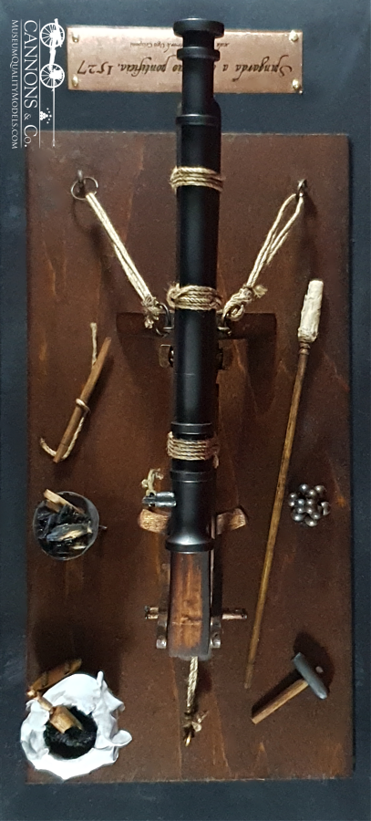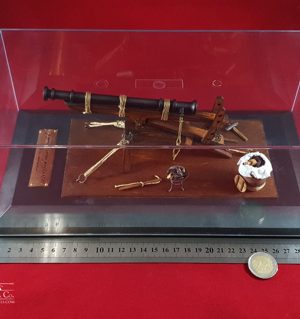© MuseumQualityModels.com

CANNONS & Co.
Museum Quality Models & Miniatures
This website is a showcase of a private collection of highend quality bronze, brass and wooden cannons, mortars and reproduction of ancient models in different scales and from different ages. Feel free to contact us if interested in purchasing any of them.

Papal Artillery, Castel Sant'Angelo. Rome, 1527
"Spingarda a cartoccio"
A fine exhibition in brass, wood and iron. An exquisitely crafted exhibition model with gunner's linstock matchholder, a realistic brazier, mallet, a barrel of black powder and other selection of instruments. Based on a '70s Italian Mantua kit, this model has been modified to match a more historically accurate representation of a 1527 "Spingarda a cartoccio". The overall model is 30 cm in lenght and is finely set in a black matt based showcase.
Scale 1:17 by Ugo Crisponi


The "Spingarda"
In the second half of the fifteenth century, the architect Francesco di Giorgio Martini made a first classification of the artillery of that period. The "Spingarda" is defined by its "ball capacity", from 10-15 pounds of stone (3.5-5kg) and a length of 8 feet (2.40m). The "Spingarda a cartoccio" represented in this model is a small, long-bore, breech-loading bombard, initially with the cannon or "mascolo" separable from the trumpet.
It appears in Leonardo da Vinci's Codice Atlantico, Foglio 32 "Spingarda a cartoccio a cavalletto". One of the many weapons invented by Leonardo.
The term "cartridge" refers to the fact that the gunpowder and projectile were loaded together in a paper or cloth casing. The use of the cartridge simplified the process of loading the weapon, speeding up the time needed to prepare and fire the shot. Once the package was inserted, a wooden piece was placed and pressed to seal the opening. The black powder was ignited through the firebox which was set on fire using a rod which had a fuse at the end called a "fire butt" or "buttafuoco". It can be said that the "Spingarda a cartoccio", used during the Renaissance, was in all respects a type of arquebus or musket, an ancient form of long-barreled rifle. This type of weapon contributed to the transition from the traditional throwing and firearm weapons of the Middle Ages towards modern rifles and muskets. The "Spingarda a cartoccio" was used both for combat and for the defense of fortifications during the Renaissance period.


" Leonardo da Vinci's Codice Atlantico, Foglio 32"
The "Bomber Corps" of the Papal Artillery. 1527
In 1527 during the "Sack of Rome" the Landsknecht mercenary troops of Charles V, mainly German and Spanish, attacked the Roman fortress of Castel Sant'Angelo in Rome defended by Swiss and Italian troops. For the defense, Benvenuto Cellini and head of the "bombardier", Antonio Santacroce, were appointed bombers for the entire duration of the siege. The "spingarde a cartoccio", together with the "falconetti", the "colubrine", the "bombardelle" and the "serpentine" were positioned on the walls of Castel Sant'Angelo.


"Reenactment" made by General Borgatti of Castel Sant'Angelo defense during the "Sack of Rome".
From STORIA DELL'ARTIGLIERIA VOL 5 by Rivista di Artiglieria e Genio Roma, 1933









©MuseumQualityModels.com
